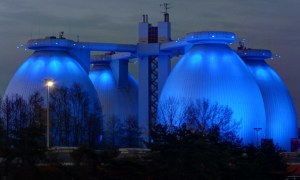🕑 Reading time: 1 minute
Septic tank collects sewage and treats it by bacterial decomposition and is generally located underground. For a better septic system, a good septic tank is important which depends on the type of material used for its construction. To select a good septic tank, one must know about the different types of septic tank materials, their advantages, and drawbacks which are briefly explained below.
Contents:
Types of Septic Tank Materials
Septic tanks are classified into 4 different types based on materials used for manufacturing and they are as follows:
- Concrete septic tank
- Steel septic tank
- Plastic septic tank
- Fiberglass septic tank
1. Concrete Septic Tank
Concrete septic tanks are massive and are generally pre-casted for easy installation. These precast concrete tanks have specific gravity around 2.40, which makes it strong to withstand the buoyant forces when placed in the ground. Their strength also increases gradually over time.
Concrete septic tanks are available in two types based on their structural configuration: single structure tanks or all-in-one systems. In single structure tanks, each chamber (such as aeration chamber, clarifier, trash tank, etc.) is pre-casted separately while in the all-in-one system, all such chambers are provided in one large tank. Some of the advantages and disadvantages of precast concrete septic tanks are given below.

Advantages
- Concrete septic tanks are heavy in weight and hence they will not float if the water table is near the tank level.
- The lifespan of concrete septic tanks is very long and they may survive for many decades.
- They are strong enough and are not easily damaged by heavy machines.
- They are rustproof.
Drawbacks
- Costly compared to other types of tank materials.
- It is hard to repair when it is damaged.
- Large equipment is required to transport and install pre-casted concrete septic tanks which makes installation more complex.
- Use of low-quality concrete mix develops cracks through which the effluent may seep out.
2. Steel Septic Tanks
Steel septic tanks are made of steel and are least popular nowadays because of their cost and low durability. The main problem associated with steel septic tanks is they deteriorate easily and quickly compared to other materials.
If the top portion of the steel septic tank gets corroded, it cannot resist any weights on top of it and may collapse suddenly at any time. Hence, while inspecting steel septic tanks, care should be taken. These type of septic tanks are not recommended nowadays.

Advantages
- Steel septic tanks are heavy in weight hence, they will not float when the water table is nearer to the tank.
- They have good resistance against buoyant forces.
Drawbacks
- Steel gets corroded easily which lowers the life span of steel tanks compared to other septic tank materials.
- High price and low durability.
- It is hard to remove corroded steel septic tanks from the ground. Their poor condition may lead to dangerous situations.

3. Plastic Septic Tanks
Plastic septic tanks are made of polyethylene plastic, hence, they are also called as poly septic tanks. They are good alternatives to concrete and steel septic tanks since they are lighter in weight and rustproof. The lighter weight makes it easier to handle and install plastic septic tanks.
Plastic septic tanks have specific gravity around 0.97 which is lesser than water specific gravity which makes the tank float when the water table is nearer to it. Hence, before installing a plastic septic tank one should examine the water table of that particular area or provide anchoring to the tank so that the floating or shifting of the tank can be eliminated. The advantages and disadvantages of plastic septic tanks are as follows.

Advantages
- Plastic septic tanks are economical compared to other types of septic tank materials.
- They are easy to handle and install.
- They have good chemical resistance.
- Rustproof.
- Good resistance against cracking.
Drawbacks
- When the water table is near to the tank bottom, it may push the tank upwards and plastic septic tanks may float due to its weight.
- They are prone to damage under critical conditions.
- Heavy weights should not be placed or moved over the plastic septic tank otherwise it will deflect and change its shape which may finally lead to the explosion of the tank due to high pressure.
4. Fiberglass Septic Tank
Fiberglass septic tanks are made using fiber reinforced plastics (FRP). They are similar to plastic septic tanks but the reinforcement of glass fibers makes them stronger than plastic tanks. They are also light in weight and easy to handle.
The lighter weight of the tank may cause floating or shifting of the tank which can be eliminated by proper anchoring of the tank to the ground. Some of the advantages and drawbacks of fiberglass septic tanks are as follows :

Advantages
- Cheaper than concrete and steel septic tanks.
- Better strength when compared to plastic septic tanks
- High Durability.
- Rustproof.
- Watertight.
Drawbacks
- Like plastic septic tanks, fiberglass septic tanks also cannot resist buoyant forces and will float or shift when the water table is nearer to them.
Read More: Septic Tank – Components and Design of Septic Tank Based on Number of Persons



